Logistics in the circular economy – how the industry can unlock its immense business potential
18.05.2020
As the world undergoes considerable change with increasing resource insufficiency, worsening climate change and their implications for the planet and its people, the need to accelerate the transition from a linear economy to a circular one has never been greater. What role can the logistics industry play in this shift?
The concept of circular economy is taking a bigger share in the sustainability conversation. In this regenerative business model, waste and resource use are minimised; when a product reaches the end of its life, it is used again to create further value. According to the European Commission, a circular economy can bring major economic benefits and contribute to innovation, growth and job creation.
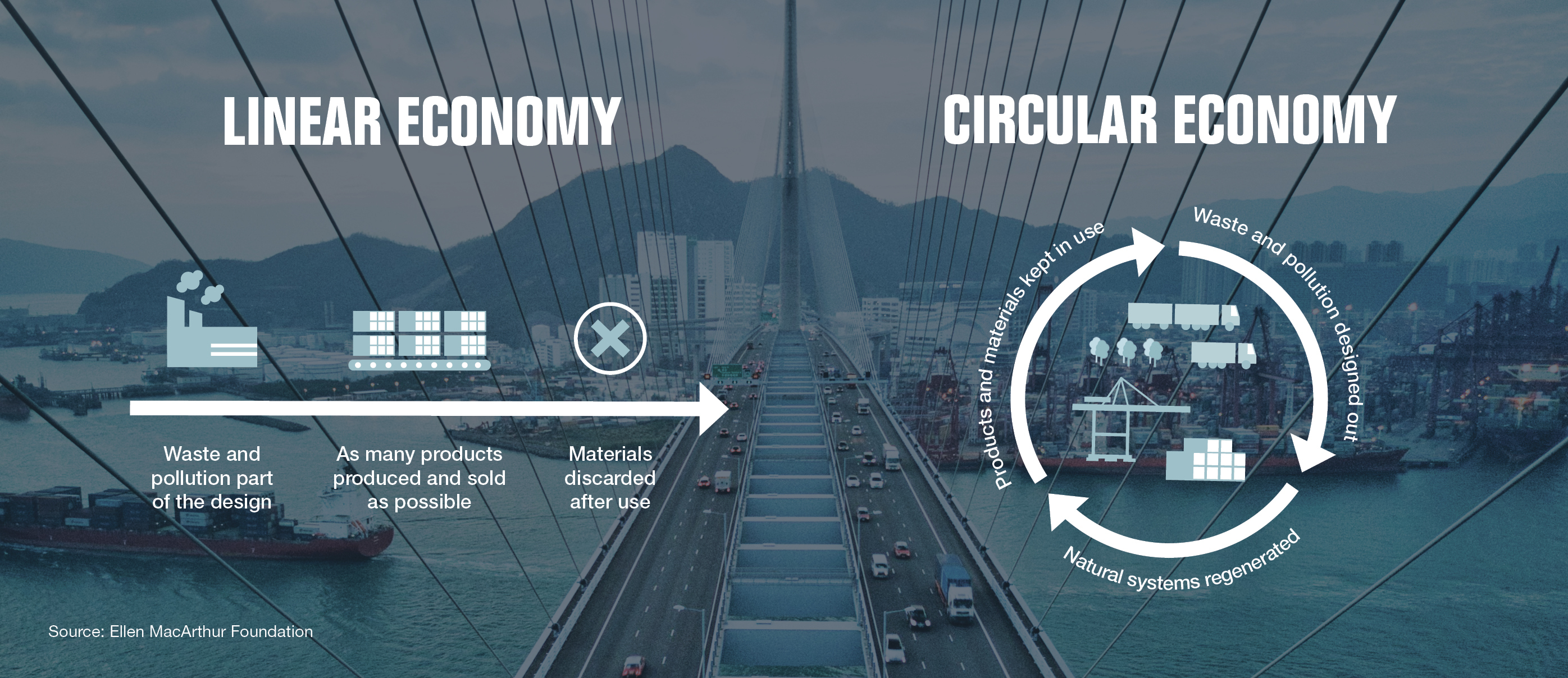
A circular economy is fundamentally different from its linear counterpart. The latter follows a “take-use-dispose” plan, meaning raw materials are extracted and collected, then transformed into products that are discarded after use. In this one-way model, value is created by producing and selling as many products as possible.
As resource insufficiency increases and climate change worsens, the call to accelerate the transition from a linear economy to a circular one has never been more urgent. Of course, important questions need to be addressed: How can we decouple economic growth from the use of virgin natural resources – and generate greater economic value with fewer natural resources? How do we maintain economic growth without sacrificing the well-being of the planet and its people?
Sector-wide disruption
The logistics industry plays a crucial role in the circular economy. “As physical resource flows become more and more complex and sophisticated, logistics will remain the key enabler to connect the dots between supply and demand,” says Kaisa Hietala, Partner, Gaia Consulting. At the sustainable business consultancy firm, she is responsible for strategic consulting, with a special focus on integrating environmental and climate challenges with business. Previously, Hietala worked as Executive Vice President of Renewable Products at Neste.

“The current linear business model, with clear supply chain segments and its related roles, has been struggling to meet the needs of circularity. The transition towards a circular business model in the logistics industry is a profound exercise that will most likely disrupt the sector,” she continues.
Circular economy in practice
Evidence of this disruption has already begun to appear. According to Mari Pantsar, Director, Finnish Innovation Fund Sitra, the logistics industry gathers many of the most eye-catching circular solutions out there, and the sector’s role in the transition is considerable. Sitra is an independent public foundation which operates directly under the supervision of the Finnish Parliament. Pantsar leads the Carbon-Neutral Circular Economy theme and is responsible for ensuring that all activities related to it help make Finland more ecologically sustainable and competitive.
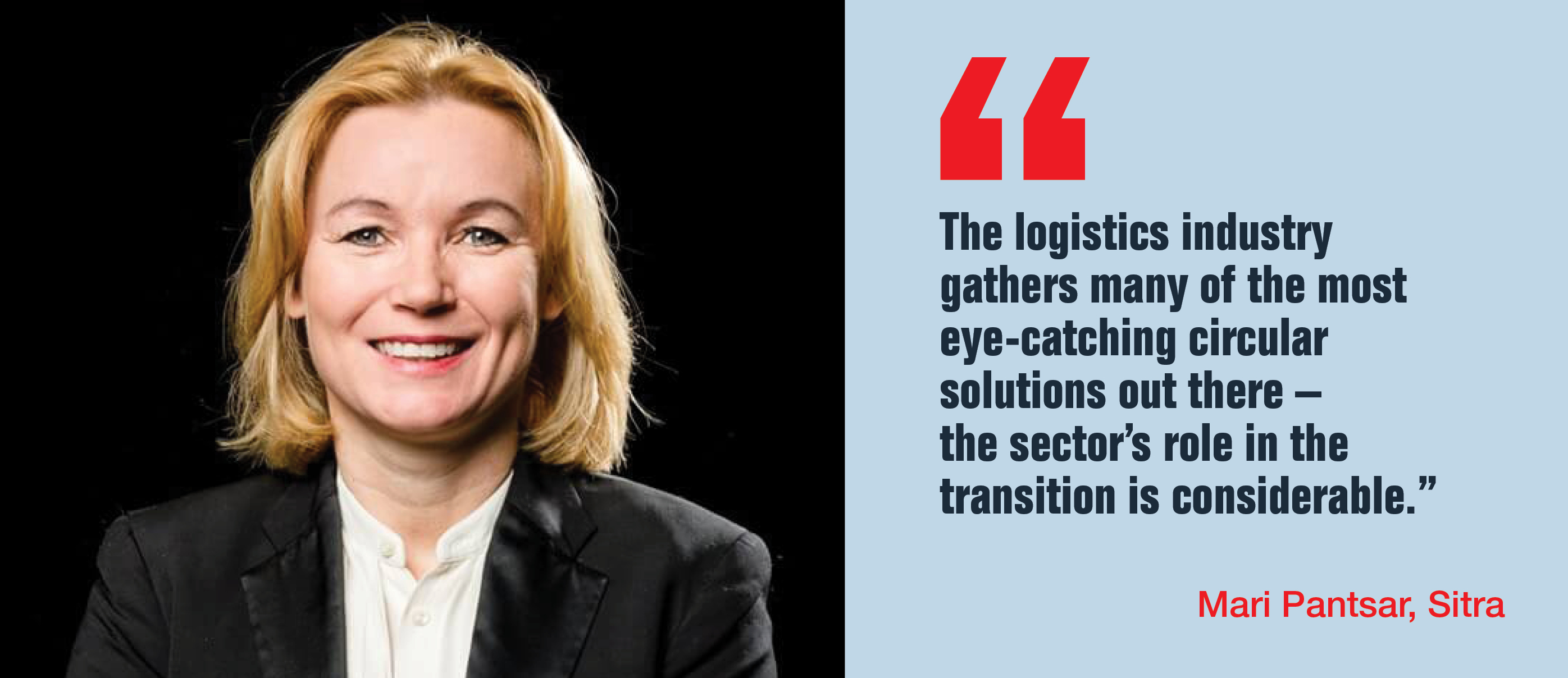
“Some solutions are highly technological and futuristic, like in Xiong’an, China, where automated delivery vehicles were put into service in 2019. In addition, Manbang Group gathered over five million out of the country’s seven million truck drivers two years ago to work as the so-called ‘Uber version of trucking’, using spare capacity and thereby avoiding transporting air,” she enumerates.
Pantsar points out Loop as another new business model enabled by smarter logistics. The platform, created by the US social enterprise TerraCycle, brings together partners such as Nestle, Unilever, and PepsiCo to allow users to order items from these companies in reusable packaging containers. “These containers can be used up to 100 times and have better functionality, like keeping your ice cream cold. They can be automatically reordered when the containers are returned.”
How circularity relates to Cargotec’s sustainability work
Cargotec recognises the immense potential of circular economics and is in the early stages of looking into the business opportunities it can offer. “As we start discussions, we are examining how circular economy can be combined with the climate work we are already carrying out as there are many times when the two can be very much interlinked,” says Päivi Koivisto, Vice President, Sustainability, Cargotec.
Circularity and sustainability stand in a long tradition of related models and visions, and certain circular economy principles are presently being implemented at Cargotec. “For example, we offer long-living products whose life cycles can be prolonged even further with good service. That is partly in place, which is a positive thing for the circular economy. Reducing the need to build new products often also saves raw materials, helping the climate. We are looking at the best way to balance our service offering with our takeback offering,” she says.
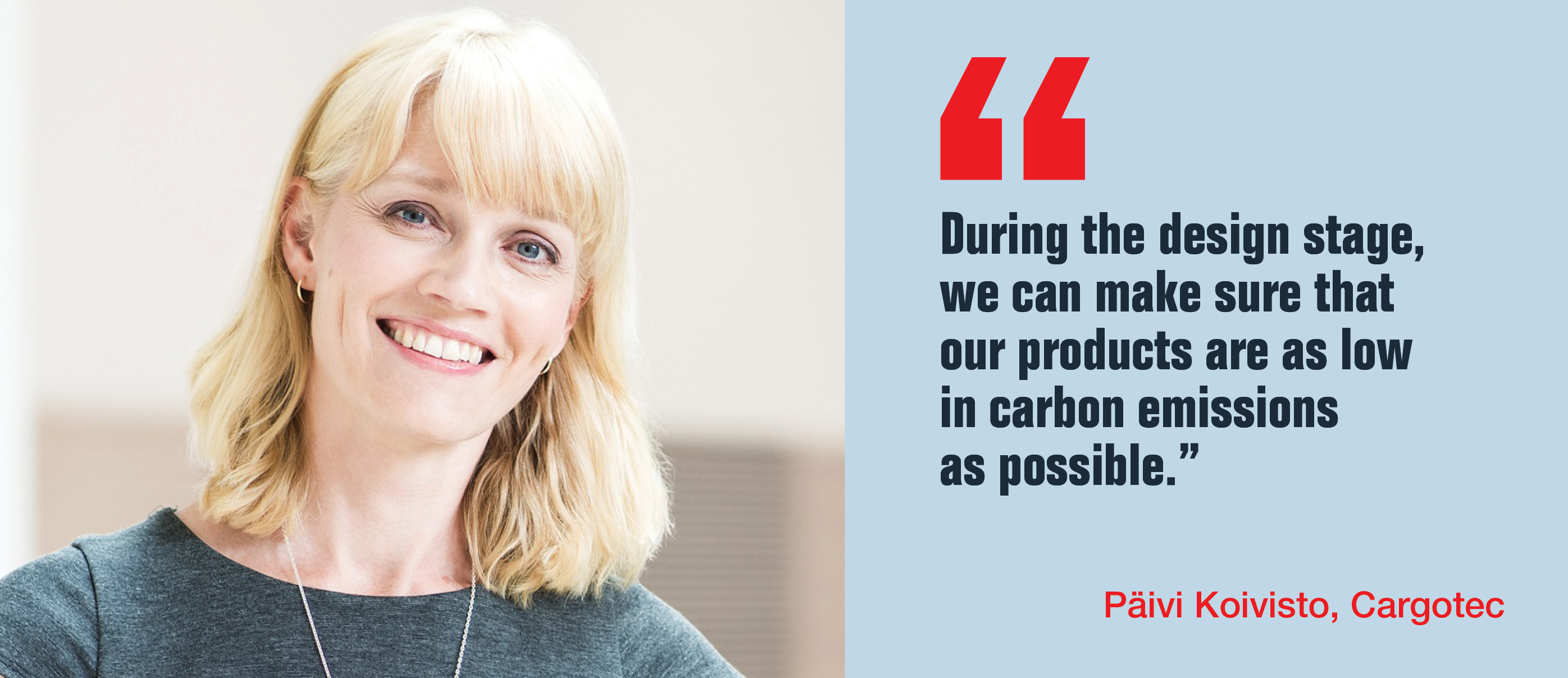
Koivisto adds that keeping the climate aspect in mind is crucial during the design phase. “It is key – design is really where it all starts and where you can have the biggest impact. During this stage, we can make sure that our products are as low in carbon emissions as possible, from the production and use phases to end of life.”
For instance, a lot of material is used to build Cargotec products, especially steel. “If you can, during the design phase, create a lighter product that would require less steel without sacrificing durability, then that would directly impact raw material procurement, resulting in savings. During the use phase, meanwhile, a lighter vehicle or product means less emissions,” she continues.
New business opportunities
Aside from connections to Cargotec’s current offerings, circular economy practices could also create completely new business opportunities. “Right now, when our customers replace equipment, we partially take them back, refurbish them and sell them in the secondhand market. We could also extend that approach to cover spare parts,” shares Mikael Laine, Senior Vice President, Strategy and member of Cargotec’s Leadership Team. “While the move would require some design thinking and process changes, this is an almost completely unused or underutilised opportunity for us.”
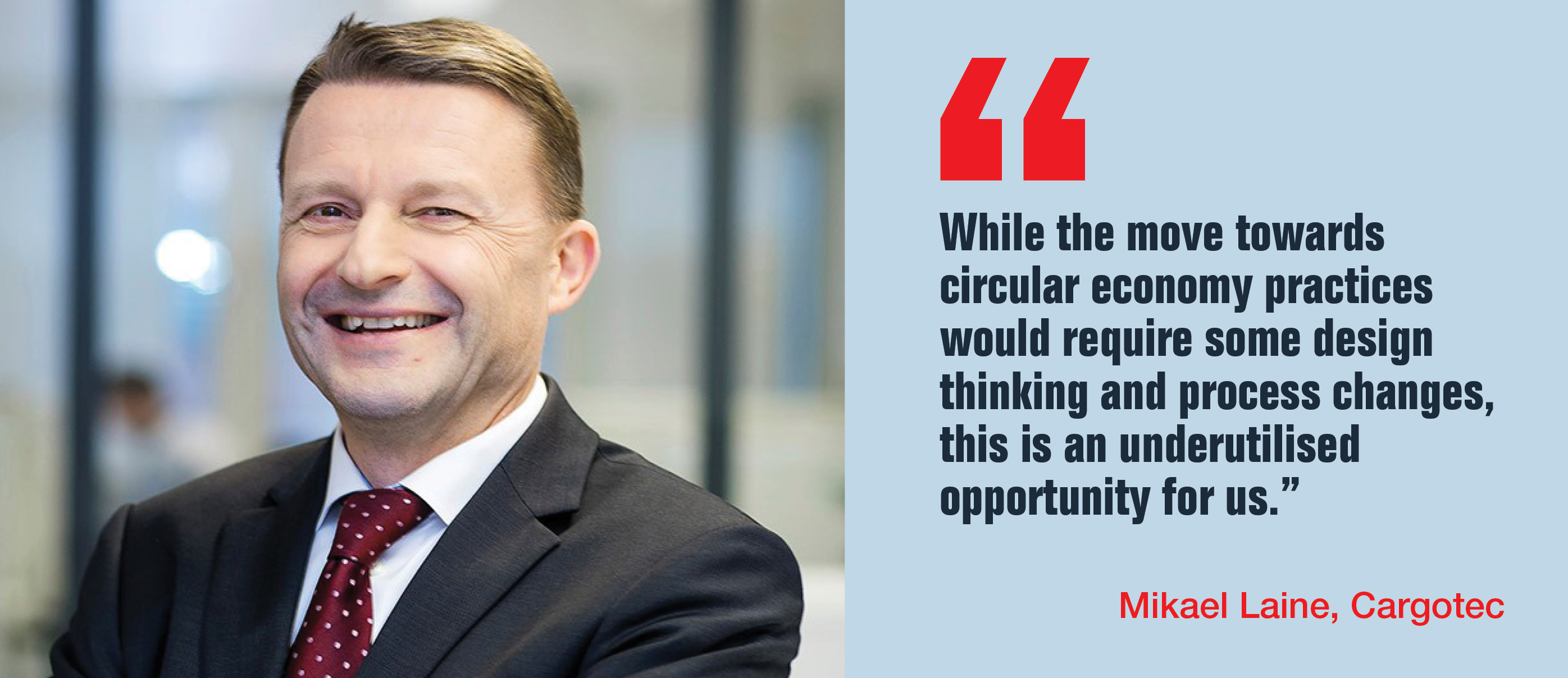
For the logistics industry to adopt a circular business model, Laine says that three parameters come to mind. “First, it is necessary to create an environment that encourages individual buy-in. The second is management support. Third, there must be market demand,” he says, noting that monitoring and understanding customer clamour in relation to circular economy is vital as Cargotec considers the potential advantage of this approach.
Reversed logistics and collaboration
The logistics industry will play a crucial role in the circular economy. “Think of the challenge for companies is to bring their products or their components in ever larger quantities back for repair, reuse, refurbishment, remanufacturing or recycling. Currently supply chains are not organised for that,” says Gijs Bruna, Senior Project Manager at Cargotec.
Reversed logistics is a cornerstone of the circular economy. Many containers are transported back empty from Europe and the Americas to Asia. Following circular economy principles, these containers could then be used to return goods and materials back to the manufacturers.
No company can become fully circular on its own as it is part of a network of other companies. Like in nature, one needs to think in ecosystems. “Cargotec can provide the equipment to enable circular business models for other companies. At the same time, it can contribute by designing its own products for circularity,” he shares. A deep understanding of the materials used and their own supply chain is hereby critical.
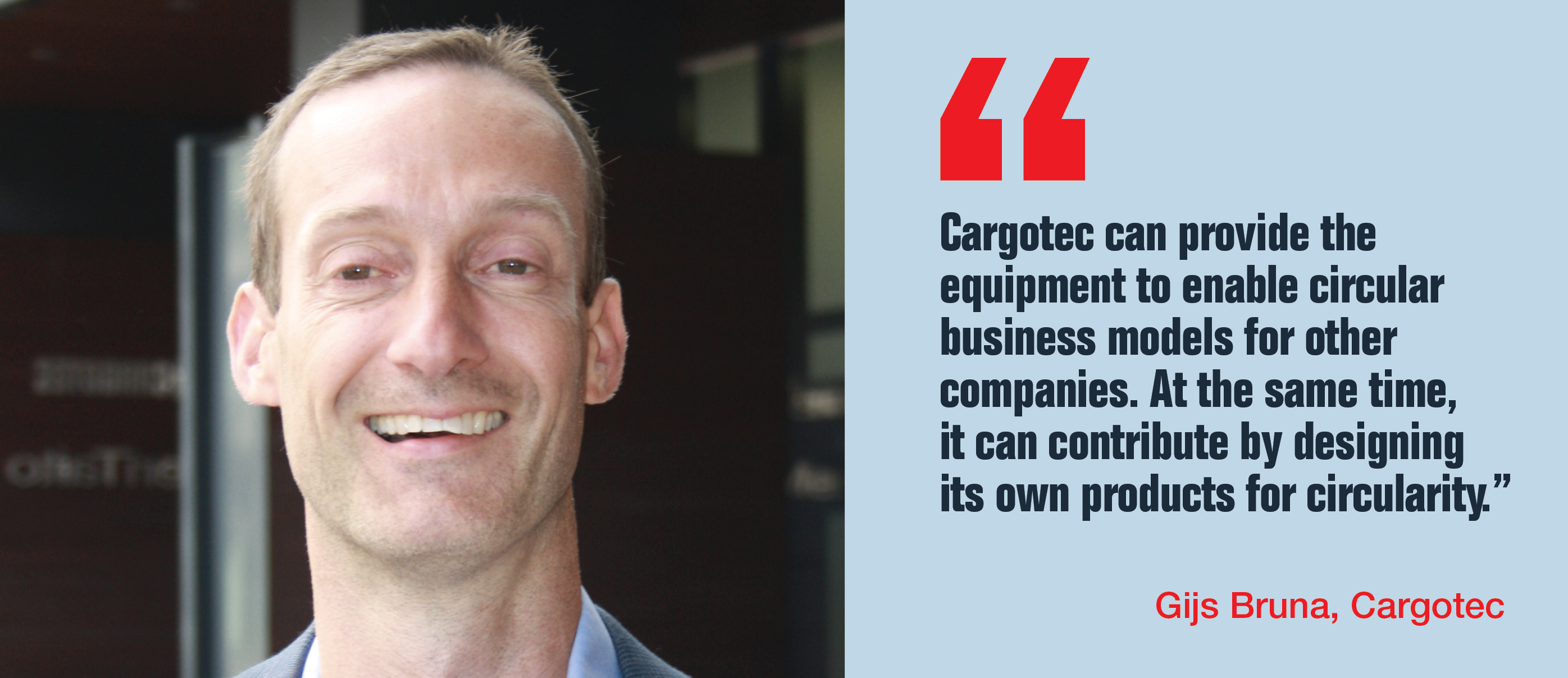
Collaboration across the supply chain is required, supporting each other in developing practices and partnerships. A good example related to Cargotec’s capital goods industry is the Capital Equipment Coalition, established in 2018 in Davos, an initiative of the Platform for Accelerating the Circular Economy (PACE) which brings together the Ellen MacArthur Foundation, World Economic Forum and key industry players in Western Europe.
What this could mean for customers
Koivisto says that making the transition to an economic system of closed loops requires an overall shift in mindset, not only for the company but for the entire logistics industry. Cargotec, for instance, could be seen as a platform to enable circular economy.
“Many of our customers today already have their own climate targets as legislation has perhaps compelled them to lower their greenhouse gas emissions. In that sense, if our products support customers’ needs and make it possible for them to achieve a lower climate impact through a cooperative model, then we have helped to promote the adoption of circular economy,” she states.
